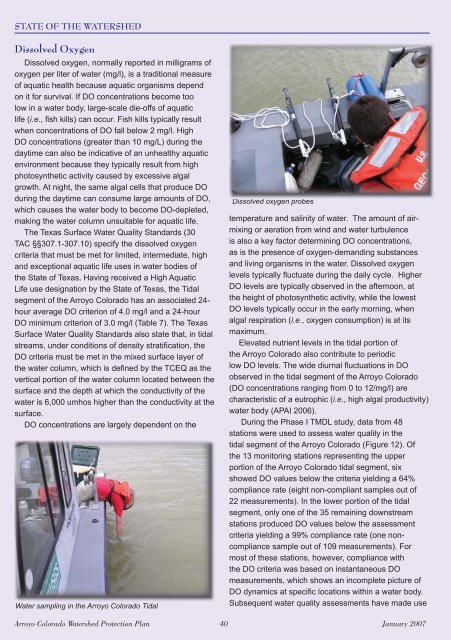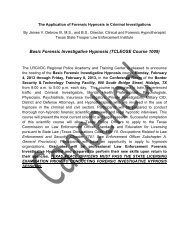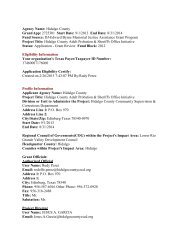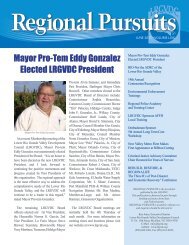Watershed Protection Plan - Lower Rio Grande Valley Development ...
Watershed Protection Plan - Lower Rio Grande Valley Development ...
Watershed Protection Plan - Lower Rio Grande Valley Development ...
You also want an ePaper? Increase the reach of your titles
YUMPU automatically turns print PDFs into web optimized ePapers that Google loves.
STATE OF THE WATERSHED<br />
Dissolved Oxygen<br />
Dissolved oxygen, normally reported in milligrams of<br />
oxygen per liter of water (mg/l), is a traditional measure<br />
of aquatic health because aquatic organisms depend<br />
on it for survival. If DO concentrations become too<br />
low in a water body, large-scale die-offs of aquatic<br />
life (i.e., fi sh kills) can occur. Fish kills typically result<br />
when concentrations of DO fall below 2 mg/l. High<br />
DO concentrations (greater than 10 mg/L) during the<br />
daytime can also be indicative of an unhealthy aquatic<br />
environment because they typically result from high<br />
photosynthetic activity caused by excessive algal<br />
growth. At night, the same algal cells that produce DO<br />
during the daytime can consume large amounts of DO,<br />
which causes the water body to become DO-depleted,<br />
making the water column unsuitable for aquatic life.<br />
The Texas Surface Water Quality Standards (30<br />
TAC §§307.1-307.10) specify the dissolved oxygen<br />
criteria that must be met for limited, intermediate, high<br />
and exceptional aquatic life uses in water bodies of<br />
the State of Texas. Having received a High Aquatic<br />
Life use designation by the State of Texas, the Tidal<br />
segment of the Arroyo Colorado has an associated 24-<br />
hour average DO criterion of 4.0 mg/l and a 24-hour<br />
DO minimum criterion of 3.0 mg/l (Table 7). The Texas<br />
Surface Water Quality Standards also state that, in tidal<br />
streams, under conditions of density stratifi cation, the<br />
DO criteria must be met in the mixed surface layer of<br />
the water column, which is defi ned by the TCEQ as the<br />
vertical portion of the water column located between the<br />
surface and the depth at which the conductivity of the<br />
water is 6,000 umhos higher than the conductivity at the<br />
surface.<br />
DO concentrations are largely dependent on the<br />
Water sampling in the Arroyo Colorado Tidal<br />
Dissolved oxygen probes<br />
temperature and salinity of water. The amount of airmixing<br />
or aeration from wind and water turbulence<br />
is also a key factor determining DO concentrations,<br />
as is the presence of oxygen-demanding substances<br />
and living organisms in the water. Dissolved oxygen<br />
levels typically fl uctuate during the daily cycle. Higher<br />
DO levels are typically observed in the afternoon, at<br />
the height of photosynthetic activity, while the lowest<br />
DO levels typically occur in the early morning, when<br />
algal respiration (i.e., oxygen consumption) is at its<br />
maximum.<br />
Elevated nutrient levels in the tidal portion of<br />
the Arroyo Colorado also contribute to periodic<br />
low DO levels. The wide diurnal fl uctuations in DO<br />
observed in the tidal segment of the Arroyo Colorado<br />
(DO concentrations ranging from 0 to 12/mg/l) are<br />
characteristic of a eutrophic (i.e., high algal productivity)<br />
water body (APAI 2006).<br />
During the Phase I TMDL study, data from 48<br />
stations were used to assess water quality in the<br />
tidal segment of the Arroyo Colorado (Figure 12). Of<br />
the 13 monitoring stations representing the upper<br />
portion of the Arroyo Colorado tidal segment, six<br />
showed DO values below the criteria yielding a 64%<br />
compliance rate (eight non-compliant samples out of<br />
22 measurements). In the lower portion of the tidal<br />
segment, only one of the 35 remaining downstream<br />
stations produced DO values below the assessment<br />
criteria yielding a 99% compliance rate (one noncompliance<br />
sample out of 109 measurements). For<br />
most of these stations, however, compliance with<br />
the DO criteria was based on instantaneous DO<br />
measurements, which shows an incomplete picture of<br />
DO dynamics at specifi c locations within a water body.<br />
Subsequent water quality assessments have made use<br />
Arroyo Colorado <strong>Watershed</strong> <strong>Protection</strong> <strong>Plan</strong> 40 January 2007









